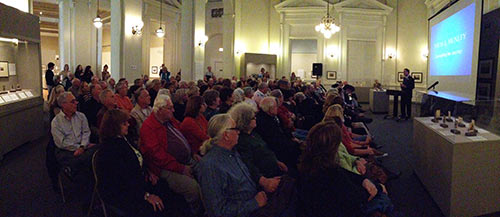As a Programming & Events intern this semester, I’ve had the great opportunity to share the room with some pretty remarkable people. This list includes guests of the Gibbes such as Jeff Rosenheim of The Metropolitan Museum of Art in New York, Charleston’s own Jonathan Green, artist Louise Halsey (daughter of Corrie McCallum and William Halsey), Lieutenant Governor Glenn McConnell, and Estée Lauder chairman emeritus Leonard Lauder. But the Gibbes has some remarkable people of its own. Its entire staff—from Executive Director Angela Mack to the custodian Russell Morrison—realizes the importance of museums as places to bring art and people together. The Gibbes staff is composed of hard workers who are dedicated to the success of the museum’s mission, to preserve and promote the art of this unique city.

To some, museums appear to be passive temples of art where visitors must be silent and detached. But the Gibbes is so invested in this community; they seek to promote an active conversation between their collection, their programs, and the public. And to initiate such great conversations, the Gibbes is bringing some really good stuff to our city.
Traveling from the Metropolitan Museum of Art, the exhibition Photography & the American Civil War presents intimate snapshots of life during the war—battlefields, street scenes, political propaganda, portraits of the young and the old. The exhibition also shows how photography influenced how we perceive the Civil War today. I was fortunate enough to talk with the Met’s curator in charge of the Department of Photography, Jeff Rosenheim, when he visited for the exhibit’s opening. He was incredibly knowledgeable about photography and its history and uses. But what impressed me most was his deep passion for the impact of photography. Jeff explained to me how photography is accessible, perhaps more so than any other medium, and how this justifies its instant popularity. He explained how photography is a democratic medium, an art form for everyone.

I believe this idea of democracy and art for all can also be found in the Gibbes’s mission. They strive to present art and programming that is relatable to everyone. Their art speaks, and is, Charleston’s history—our history. If you love our city, then there is absolutely no way that you could not love what the Gibbes has to offer. I am incredibly grateful for the opportunity I’ve had this semester to work with such a dedicated team of art managers who care so greatly about art and its influence in Charleston. Like I mentioned above, the Gibbes team is truly committed to their work in this community and this is what will always stick with me long after my internship is over. I know what I’ve learned here will benefit me wherever I end up in the art world, and I’m proud to call Charleston, the Gibbes, and its great art my starting point.

—Amelia Roland, Public Programs & Marketing Intern and guest blogger
Published December 5, 2013

